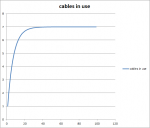Killswitch
FH is my second home
- Joined
- Jan 29, 2004
- Messages
- 1,584
I can't do it, please help me!
I have 7 buttons in a booth. People enter the booth one at a time and press one button. How do I work out how many people I need to express a percentage confidence that all seven buttons will have been pressed?
Obviously the minimum number of people is 7 and I would reach 100% probability that all seven buttons were pressed after an infinite number of people had entered the booth. But let's say I just wanted to be 95% sure that all seven buttons had been pressed?
I've been reading and thinking back to school and I just can't do it!
I have 7 buttons in a booth. People enter the booth one at a time and press one button. How do I work out how many people I need to express a percentage confidence that all seven buttons will have been pressed?
Obviously the minimum number of people is 7 and I would reach 100% probability that all seven buttons were pressed after an infinite number of people had entered the booth. But let's say I just wanted to be 95% sure that all seven buttons had been pressed?
I've been reading and thinking back to school and I just can't do it!


